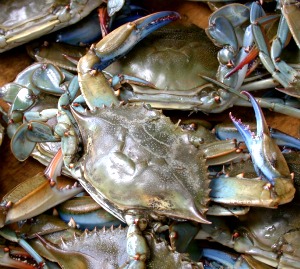 Softshell crab is a crustacean seafood that can be eaten whole if cooked shortly after molting their hard shell. As crabs grow larger, their shells cannot expand, so they molt the exteriors and have a soft covering for a matter of days when they are vulnerable and considered usable. Fisherman often put crabs beginning to molt aside, until the molting process is complete in order to send them to market as soft-shells. Crabs should be kept alive until immediately before cooking so they are fresh. Usually crabs must be eaten within four days of molting to be useful as soft-shell crabs. They begin to rebuild their shells after that, and when eaten, have a thin shell. These are often referred to as “papershells” or “tinbacks” and are more crunchy when eaten, making them less desirable to some.
Softshell crab is a crustacean seafood that can be eaten whole if cooked shortly after molting their hard shell. As crabs grow larger, their shells cannot expand, so they molt the exteriors and have a soft covering for a matter of days when they are vulnerable and considered usable. Fisherman often put crabs beginning to molt aside, until the molting process is complete in order to send them to market as soft-shells. Crabs should be kept alive until immediately before cooking so they are fresh. Usually crabs must be eaten within four days of molting to be useful as soft-shell crabs. They begin to rebuild their shells after that, and when eaten, have a thin shell. These are often referred to as “papershells” or “tinbacks” and are more crunchy when eaten, making them less desirable to some.
In the United States where softshell farming is already established, the blue crab (Callinectes sapidus) is used typically. This aquaculture is relatively new in Asia that grows mangrove crab. This aquaculture could grow in the Philippines where blue swimming crabs and mangrove crabs are naturally found.
Cleaning of Softshell Crabs
Cleaning or dressing softshell crabs is not hard to do. A paring knife or kitchen scissors is all you need. You need to cut away three distinct parts of the crab, the lungs, the apron and the head section.
The lungs are right under each side of the pointed end of the top shell. The top shell is flipped over or back as you cut. Do not pull the shell off completely. On a soft shell crab the top shell is held on only by the center section of the crab.
The apron is pulled back from the crab. That part needs to come off. Next is cutting out head section (eyes and mouth). Take the kitchen shears and cut a small wedge of sorts to remove the eye and mouth section.
Another preparation method is to cut the crab totally in half from the eyes to the back, you can do this with the shears. This will allow you to clean the intestines out and allows for a little bit quicker cooking.
For additional information, contact:
MS. NONITA S. CABACABA
Center Chief
Guluan Marine Fisheries Development Center
Bureau of Fisheries and Aquatic Resource 8
Guluan, Eastern Samar
Tel: +63 (55) 271-2583
Mobile: 09177067544
Email: [email protected]
Sources: trc.dost.gov.ph, cookinglouisiana.com; Photos: en.wikipedia.org